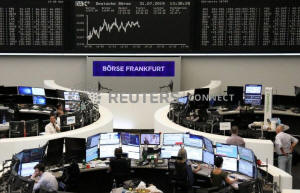Mind your backs, dollar coming through!
 Send a link to a friend
Send a link to a friend
 [August 01, 2019]
By Marc Jones and Swati Pandey [August 01, 2019]
By Marc Jones and Swati Pandey
LONDON/SYDNEY (Reuters) - The dollar
charged to its highest in more than two years on Thursday after the
Federal Reserve spoiled hopes of a run of U.S. interest rate cuts.
A blizzard of global data and events was going on, but it was Fed Chair
Jerome Powell's remarks on Wednesday that set the markets running.
Powell said the first U.S. rate cut in over a decade was "not the
beginning of a long series of rate cuts" .
The dollarís reaction said it all. The DXY index surged to its highest
in more than two years, euro/dollar dropped below $1.11 for the first
time since May 2017, and Brexit-hobbled sterling hit 30-month lows just
above $1.21.
World stocks had recoiled overnight and emerging markets had their
longest run of falls in almost a year. [EMRG/FRX]
"Markets interpreted the Fedís communication as slightly hawkish and
therefore further rate cuts in the immediate future were somewhat priced
out," said David Milleker, senior economic advisor at Union Investment.
"And the dollar strengthened. All in all, the Fed did not achieve what
it presumably wanted."

U.S. Treasuries were sold off as investors scaled back their pre-Fed
expectations for at least 100 basis points of cuts in the near term.
Yields on 10-year notes climbed as high as 2.058% in Europe from a U.S.
close of 2.007%.
Core euro zone bond yields were rising, too, although -0.428% German
Bund levels were still extraordinary. "I didnít say itís just one rate
cut," Powell had been careful to emphasise after Wednesday's
25-basis-point move.
Instead, he characterized it as "a mid-cycle adjustment to policy",
citing signs of a global slowdown, U.S. trade tensions and a desire to
boost inflation.
Wall Street fell afterwards and E-minis futures for the S&P 500 were
pointing 0.15% lower.
MSCI's broadest index of Asia-Pacific shares outside Japan fell 0.8%,
extending losses for a fifth day to the lowest since mid-June and
posting its biggest one-day percentage drop in a month.
Japan's Nikkei rose, reversing early declines. Australian shares
declined 0.4%. Losses by Chinese shares ended down 0.8%.
"We believe the Fed is trying to thread the needle, balancing market
jitters about slowing global growth with robust consumer spending and a
strong job market in the U.S.," said Nick Maroutsos, co-head of global
bonds at Janus Henderson.
"In other words, by cutting just 25 bps, the Fed is trying to bolster
market confidence while also keeping some dry powder in reserve in case
of an economic shock."
TRADE TALKS
Adding to worries, the United States and China on Wednesday ended a
brief round of talks without much progress in ending their year-long
trade war.
[to top of second column]
|

The German share price index DAX graph is pictured at the stock
exchange in Frankfurt, Germany, July 31, 2019. REUTERS/Staff

Downbeat data and factory surveys on Thursday had also pointed to
further weakness for Asia's trade-reliant economies.
South Korea's exports fell for an eighth straight month in July amid
weak global demand and a dispute with Japan. New export orders
shrank the most in about six years.
South Korea, the world's sixth-largest exporter, is the first major
industrial economy to release trade data each month, providing an
early assessment on the health of global demand.
Pressure on Chinese factories eased slightly, but manufacturing
activity continued to shrink.
"The broader global trade dynamic remains a challenge," Morgan
Stanley strategist Michael Zezas said. "Trade should continue to
drag on corporate confidence, capex and global growth in the near
term."
In Europe's foreign exchange markets, sterling dropped as low as
$1.2101 before a Bank of England meeting that's expected to leave
its 0.75% interest rate unchanged but result in plenty of
interesting discussion.
Fears of a no-deal Brexit now that Boris Johnson is prime minister
continue to afflict the pound, although it was fractionally higher
against a weakening euro at 91.17 pence.
"Sterling remains vulnerable to a further escalation in Brexit
tensions and we anticipate the market will likely discount higher
risks of a Ďno dealí outcome in the weeks ahead," said Roger Hallam,
currency chief investment officer at J.P. Morgan Asset Management.
Elsewhere, the Aussie dollar slipped below key chart support of
$0.6832 to as low as $0.6828, a level not seen since an early
January "flash crash".
The kiwi hit a six-week trough of $0.6535 on expectations the
Reserve Bank of New Zealand will cut rates next week.
U.S. crude futures fell 76 cents to $57.82 per barrel after comments
on the rate outlook. Brent was down 71 cents at $64.34. [O/R]
Spot gold also fell, to $1,405.26. [GOL/]
(Reporting by Marc Jones, editing by Larry King)
[© 2019 Thomson Reuters. All rights
reserved.]
Copyright 2019 Reuters. All rights reserved. This material may not be published,
broadcast, rewritten or redistributed.
Thompson Reuters is solely responsible for this content.
 |